Health Monitoring of Metallic Structures with Electromechanical Impedance and Piezoelectric Sensors
Abstract
:1. Introduction
2. Theoretical Methods
2.1. Derivation of Sensitive Component
2.2. DCMI Signature Extracting Model
3. Experimental Setup
3.1. Experiments on Aluminum Plates (Specimen-1 and -2)
3.2. Experiment on the Real Aircraft Fuselage (Specimen-3)
4. Results and Discussion
4.1. Comparative Analysis of Damage In-Situ Propagation on Specimen-1
4.2. Comparative Analysis of Multi-Damage Development on Specimen-2
4.3. Comparative Analysis of Damage Growth on Fuselage (Specimen-3)
5. Conclusions
- (1)
- As long as the PZT is surface-bonded on the structures, the DCMI methodology can be used for monitoring the damage propagation on simple and complex structures, which are made of metals, metal-matrix nanomaterials and composites.
- (2)
- More obvious peaks can be extracted from the raw signatures with the use of DCMI methodology, which may have potential applications in the SHM community in the future.
- (3)
- The correlation between damages growing and signatures variation can be well quantified via combing DCMI signatures with the RMSD index.
- (4)
- The DCMI methodology can extract more sensitive signatures from measured raw signatures in a simpler way.
- (5)
- The susceptance signatures can also be used for assessing the regularity of damage changing after extracting signatures with the DCMI.
Author Contributions
Funding
Conflicts of Interest
Nomenclatures
| Complex symbol | |
| Angular frequency (rad/s) | |
| Capacitance symbol (F) | |
| Dielectric constant (F/m) | |
| Radius of circular PZT (m) | |
| Thickness of circular PZT (m) | |
| Coupling coefficient | |
| Piezoelectric strain constant (×10−12 C/N) | |
| Compliance coefficient (m2/N) | |
| Poisson ratio | |
| Wavenumber (m−1) | |
| Phase velocity (m/s) | |
| Density (kg/m) | |
| Mechanical loss factor | |
| Dielectric loss factor | |
| Variable of Bessel function | |
| Mechanical impedance of PZT under short-circuited condition (Ω) | |
| Mechanical impedance of host structure (Ω) | |
| Symbol related to adhesive layer beneath PZT | |
| Non-sensitive component in admittance model (S) | |
| Sensitive component in admittance model (S) | |
| Admittance (S) | |
| Raw conductance in parallel measurement mode (S) | |
| Raw conductance in serial measurement mode (S) | |
| Raw susceptance in parallel measurement mode (S) | |
| Raw susceptance in serial measurement mode (S) | |
| Real part of complex capacitance (F) | |
| Imaginary part of complex capacitance (F) | |
| Real part of complex wavenumber (m−1) | |
| Imaginary part of complex wavenumber (m−1) | |
| 1-order Bessel function of the first kind | |
| 0-order Bessel function of the first kind | |
| Real part of complex fraction of Bessel function | |
| Imaginary part of complex fraction of Bessel function | |
| Real part of the variable in Bessel function | |
| Imaginary part of the variable in Bessel function | |
| Modulus of DCMI signatures | |
| Real part of DCMI signatures | |
| Imaginary part of DCMI signatures |
References
- Gros, X. NDT Data Fusion; Edward Arnold Publishers Ltd.: London, UK, 1997. [Google Scholar] [CrossRef]
- Bastian, B.T.; Jaspreeth, N.; KumarRanjith, S.; Jiji, C.V. Visual inspection and characterization of external corrosion in pipelines using deep neural network. NDT E Int. 2019, 107, 102134. [Google Scholar] [CrossRef]
- Adamus, K.; Adamus, J.; Lacki, J. Ultrasonic testing of thin walled components made of aluminum based laminates. Compos. Struct. 2018, 202, 95–101. [Google Scholar] [CrossRef]
- Mizukami, K.; Ibrahim, A.S.b.; Ogi, K.; Matvieieva, N.; Kharabet, L.; Schulze, M.; Heuer, H. Enhancement of sensitivity to delamination in eddy current testing of carbon fiber composites by varying probe geometry. Compos. Struct. 2019, 226, 11127. [Google Scholar] [CrossRef]
- Shipway, N.J.; Barden, T.J.; Huthwaite, P.; Lowe, M.J.S. Automated defect detection for Fluorescent Penetrant Inspection using Random Forest. NDT E Int. 2019, 101, 113–123. [Google Scholar] [CrossRef]
- Alani, A.M.; Aboutalebi, M.; Kilic, G. Integrated health assessment strategy using NDT for reinforced concrete bridges. NDT E Int. 2014, 61, 80–94. [Google Scholar] [CrossRef]
- Qing, X.; Li, W.; Wang, Y.; Sun, H. Piezoelectric Transducer-Based Structural Health Monitoring for Aircraft Applications. Sensors 2019, 19, 545. [Google Scholar] [CrossRef]
- Liu, Q.; Sun, H.; Wang, T.; Qing, X. On-Site Health Monitoring of Composite Bolted Joint Using Built-In Distributed Eddy Current Sensor Network. Materials 2019, 12, 2785. [Google Scholar] [CrossRef]
- Hu, X.; Zhu, H.; Wang, D. A study of concrete slab damage detection based on the electromechanical impedance method. Sensors 2014, 14, 19897–19909. [Google Scholar] [CrossRef]
- Karayannis, C.G.; Voutetaki, M.E.; Chalioris, C.E.; Providakis, C. Detection of flexural damage stages for RC beams using Piezoelectric sensors (PZT). Smart Struct. Syst. 2015, 15, 997–1018. [Google Scholar] [CrossRef]
- Karayannis, C.G.; Chalioris, C.E.; Angeli, G.M.; Papadopoulos, N.A.; Favvata, M.J.; Providakis, C.P. Experimental damage evaluation of reinforced concrete steel bars using piezoelectric sensors. Constr. Build. Mater. 2016, 105, 227–244. [Google Scholar] [CrossRef]
- Voutetaki, M.E.; Papadopoulos, N.A.; Angeli, G.M.; Providakis, C.P. Investigation of a new experimental method for damage assessment of RC beams failing in shear using piezoelectric transducers. Eng. Struct. 2016, 114, 226–240. [Google Scholar] [CrossRef]
- Chalioris, C.E.; Karayannis, C.G.; Angeli, G.M.; Papadopoulos, N.A.; Favvata, M.J.; Providakis, C.P. Applications of smart piezoelectric materials in a wireless admittance monitoring system (WiAMS) to Structures—Tests in RC elements. Case Stud. Constr. Mater. 2016, 5, 1–18. [Google Scholar] [CrossRef]
- Perera, R.; Pérez, A.; García-Diéguez, M.; Zapico-Valle, J.L. Active Wireless System for Structural Health Monitoring Applications. Sensors 2017, 17, 2880. [Google Scholar] [CrossRef] [PubMed]
- Rucka, M. Monitoring Steel Bolted Joints during a Monotonic Tensile Test Using Linear and Nonlinear Lamb Wave Methods: A Feasibility Study. Metals 2018, 8, 683. [Google Scholar] [CrossRef]
- Ramadas, C.; Padiyar, J.; Balasubramaniam, K.; Joshi, M. Lamb wave based ultrasonic imaging of interface delamination in composite T-joint. NDT E Int. 2011, 44, 523–530. [Google Scholar] [CrossRef]
- Qiu, L.; Yan, X.; Lin, X.; Yuan, S. Multiphysics simulation method of lamb wave propagation with piezoelectric transducers under load condition. Chin. J. Aeronaut. 2019, 32, 1071–1086. [Google Scholar] [CrossRef]
- Xu, B.; Yuan, S.; Wang, M.; Qiu, L. Determining impact induced damage by lamb wave model extracted by EMD method. Measurement 2015, 65, 120–128. [Google Scholar]
- Qiu, L.; Liu, B.; Yuan, S.; Su, Z.; Ren, Y. A scanning spatial-wavenumber filter and PZT 2-D cruciform array based on-line damage imaging method of composite structure. Sens. Actuators A 2016, 248, 62–72. [Google Scholar] [CrossRef]
- Qiu, L.; Liu, B.; Yuan, S.; Su, Z. Impact imaging of aircraft composite structure based on a model-independent spatial-wavenumber filter. Ultrasonics 2016, 64, 10–24. [Google Scholar] [CrossRef]
- Gao, D.; Wu, Z.; Yang, L.; Zheng, Y.; Yin, W. Structural health monitoring for long-term aircraft storage tanks under cryogenic temperature. Aerosp. Sci. Technol. 2019, 92, 881–891. [Google Scholar] [CrossRef]
- Kuznetsov, S.V. Closed form analytical solution for dispertion of lamb waves in FG plates. Wave Motion 2019, 84, 1–7. [Google Scholar] [CrossRef]
- Mori, N.; Biwa, S.; Kusaka, T. Damage localization method for plates based on the time reversal of the model-converted lamb waves. Ultrasonics 2019, 91, 19–29. [Google Scholar] [CrossRef] [PubMed]
- Bisheh, H.K.; Wu, N. Analysis of wave propagation characteristics in piezoelectric cylindrical composite shells reinforced with carbon nanotubes. Int. J. Mech. Sci. 2018, 145, 200–220. [Google Scholar] [CrossRef]
- Yan, D.J.; Chen, A.L.; Wang, Y.S.; Zhang, C.; Golub, M. In-plane elastic wave propagation in nanoscale periodic layered piezoelectric structures. Int. J. Mech. Sci. 2018, 142, 276–288. [Google Scholar] [CrossRef]
- Liang, C.; Sun, F.; Rogers, C.A. Coupled Electro-Mechnical Analysis of Adaptive Material Systems-Determination of the Actuator Power Consumption and System Energy Transfer. J. Intell. Mater. Syst. Struct. 1997, 8, 12–20. [Google Scholar] [CrossRef]
- Annamdas, V.G.M.; Soh, C.K. Three-dimensional electromechanical impedance model. I: Formulation of directional sum impedance. J. Aerosp. Eng. 2007, 20, 53–62. [Google Scholar] [CrossRef]
- Annamdas, V.G.M.; Soh, C.K. Three-dimensional electromechanical impedance Model. II: Damage analysis and PZT characterization. J. Aerosp. Eng. 2007, 20, 63–71. [Google Scholar] [CrossRef]
- Bhalla, S.; Soh, C.K. Structural health monitoring by piezo-impedance transducers. I: Modeling. J. Aerosp. Eng. 2004, 17, 154–165. [Google Scholar] [CrossRef]
- Giurgiutiu, V.; Reynolds, A.; Rogers, C.A. Experimental investigation of electromechanical impedance health monitoring for spot-welded structural joints. J. Intell. Mater. Syst. Struct. 1999, 10, 802–812. [Google Scholar] [CrossRef]
- Jin, C.; Wang, X. Analytical modelling of the electromechanical behaviourof surface-bonded piezoelectric actuators including the adhesive layer. Eng. Fract. Mech. 2011, 78, 2547–2562. [Google Scholar] [CrossRef]
- Sun, F.P.; Chaudhry, Z.; Rogers, C.A.; Majmundar, M.; Liang, C. Automated real-time structure health monitoring via signature patter recognition. In Proceedings of the SPIE Conference on Smart Materials and Structures, San Diego, CA, USA, 26 February–3 March 1995. [Google Scholar]
- Zhou, S.W.; Liang, C.; Rogers, C.A. An impedance-based system modeling approach for induced strain actuator-driven structures. J. Vib. Acoust. 1996, 118, 323–332. [Google Scholar] [CrossRef]
- Ai, D.; Zhu, H.; Luo, H.; Yang, J. An effective electromechanical impedance technique for steel structural health monitoring. Constr. Build. Mater. 2014, 73, 97–104. [Google Scholar] [CrossRef]
- Na, W.S.; Lee, H. Experimental investigation for an isolation technique on conducting the electromechanical impedance method in high-temperature pipeline facilities. J. Sound Vib. 2016, 383, 210–220. [Google Scholar] [CrossRef]
- Zuo, C.; Feng, X.; Zhang, Y.; Lu, L.; Zhou, J. Crack detection in pipelines using multiple electromechanical impedance sensors. Smart Mater. Struct. 2017, 26, 104004. [Google Scholar] [CrossRef]
- Zhu, J.; Wang, Y.; Qing, X. A real-time electromechanical impedance-based active monitoring for composite patch bonded repair structure. Compos. Struct. 2019, 212, 513–523. [Google Scholar] [CrossRef]
- Zhu, J.; Wang, Y.; Qing, X. Modified electromechanical impedance-based disbond monitoring for honeycomb sandwich composite structure. Compos. Struct. 2019, 217, 175–185. [Google Scholar] [CrossRef]
- Li, H.; Wang, X.; Chen, J. Nonlinear electro-mechanical coupling vibration of corrugated graphene/piezoelectric laminated structures. Int. J. Mech. Sci. 2019, 150, 705–714. [Google Scholar] [CrossRef]
- Prasath, S.S.; Arockiarajan, A. Effective electromechanical response of macro-fiber composite (MFC): Analytical and numerical models. Int. J. Mech. Sci. 2013, 77, 98–106. [Google Scholar] [CrossRef]
- Wang, L.; Hofmann, V.; Bai, F.; Jin, J.; Liu, Y.; Twiefel, J. Systematic electromechanical transfer matrix model of a novel sandwiched type flexural piezoelectric transducer. Int. J. Mech. Sci. 2018, 138, 229–243. [Google Scholar] [CrossRef]
- Li, W.; Liu, T.; Zou, D.; Wang, J.; Yi, T.H. PZT based smart corrosion coupon using electromechanical impedance. Mech. Syst. Sig. Process. 2019, 129, 455–469. [Google Scholar] [CrossRef]
- Lim, Y.Y.; Tang, Z.S.; Smith, S.T. Piezoelectric based Monitoring of Structural Adhesives curing A novel Experimental Study. Smart Mater. Struct. 2019, 28, 015016. [Google Scholar] [CrossRef]
- Al-Sabagh, A.; Taha, E.; Kandil, U.; Nasr, G.A.; Taha, M.R. Monitoring Damage Propagation in Glass Fiber Composites Using Carbon Nanofibers. Nanomaterials 2016, 6, 169. [Google Scholar] [CrossRef] [PubMed]
- Alam, M.; Mahmood, A.; Azam, S.; Butt, M.S.; Haq, A.U.; Massoud, Y. Impedance model of cylindrical nanowires for metamaterial applications. Nanomaterials 2019, 9, 1104. [Google Scholar] [CrossRef] [PubMed]
- Lee, J.H.; Park, Y.C. Nondestructive characterization of metal matrix composite by ultrasonic measurement. Compos. Eng. 1995, 5, 1423–1431. [Google Scholar] [CrossRef]
- Liaw, P.K.; Shannon, R.E.; Clark, W.G., Jr.; Harrigan, W.C., Jr.; Jeong, H.; Hsu, D.K. Nondestructive characterization of meaterial properties of metal-matrix composites. Mater. Chem. Phys. 1995, 39, 220–228. [Google Scholar] [CrossRef]
- Podymova, N.B.; Kalashnikov, I.E.; Bolotova, L.K.; Kobeleva, L.I. Laser-ultrasonic nondestructive evaluation of porosity in particulate reinforced metal-matrix composites. Ultrasonics 2019, 99, 105959. [Google Scholar] [CrossRef] [PubMed]
- Rokhlin, S.I.; Chu, Y.C.; Huang, W. Ultrasonic evaluation of fatigue damage in metal matrix composites. Mech. Mater. 1995, 21, 251–263. [Google Scholar] [CrossRef]
- Salur, E.; Aslan, A.; Kuntoglu, M.; Gunes, A.; Sahin, O.S. Experimental study and analysis of machinability characteristics of metal matrix composites during drilling. Compos. Part B Eng. 2019, 166, 401–413. [Google Scholar] [CrossRef]
- Zhu, J.; Wang, Y.; Qing, X. A novel electromechanical impedance model for surface-bonded circular piezoelectric transducer. Smart Mater. Struct. 2019. [Google Scholar] [CrossRef]
- Xu, Y.G.; Liu, G.R. A modified electro-mechanical impedance model of piezoelectric actuator-sensors for debonding of composite patches. J. Intell. Mater. Syst. Struct. 2002, 13, 389–396. [Google Scholar] [CrossRef]
- Bhalla, S.; Soh, C.K. Structural Health Monitoring by Piezo-Impedance Transducers. II: Applications. J. Aerosp. Eng. 2004, 17, 166–175. [Google Scholar] [CrossRef]
- Giurgiutiu, V.; Lin, B. In-situ fabricated smart material active sensors for structural health monitoring. In Proceedings of the Smart Materials III, Sydney, Australia, 12–15 December 2004. [Google Scholar]
- Giurgiutiu, V.; Zagrai, A.N. Embedded self-sensing piezoelectric active sensors for on-line structural identification. J. Vib. Acoust. 2002, 124, 116–125. [Google Scholar] [CrossRef]
- Park, G.; Sohn, H.; Farrar, C.R.; Inman, D.J. Overview of piezoelectric impedance-based health monitoring and path forward. Shock Vib. Dig. 2003, 35, 451–463. [Google Scholar] [CrossRef]



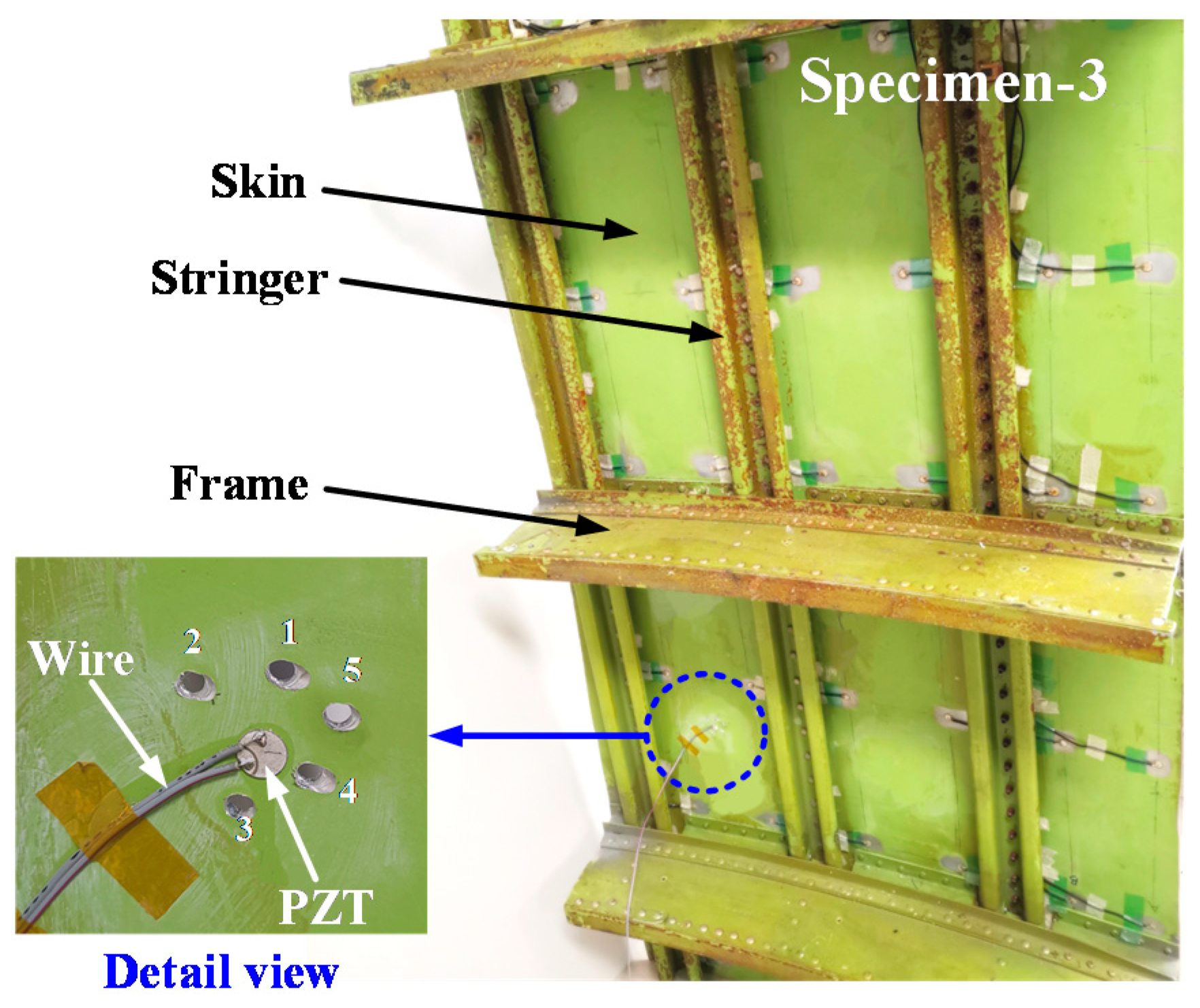
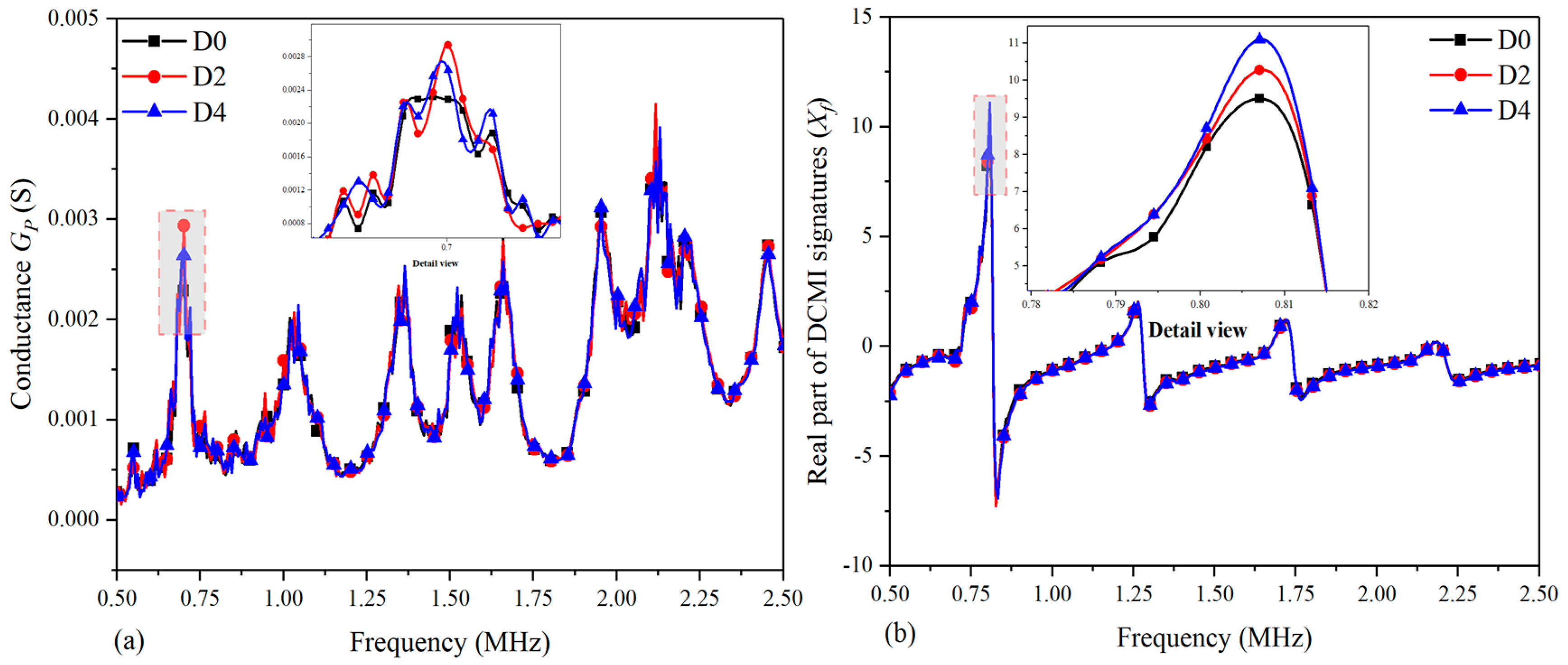

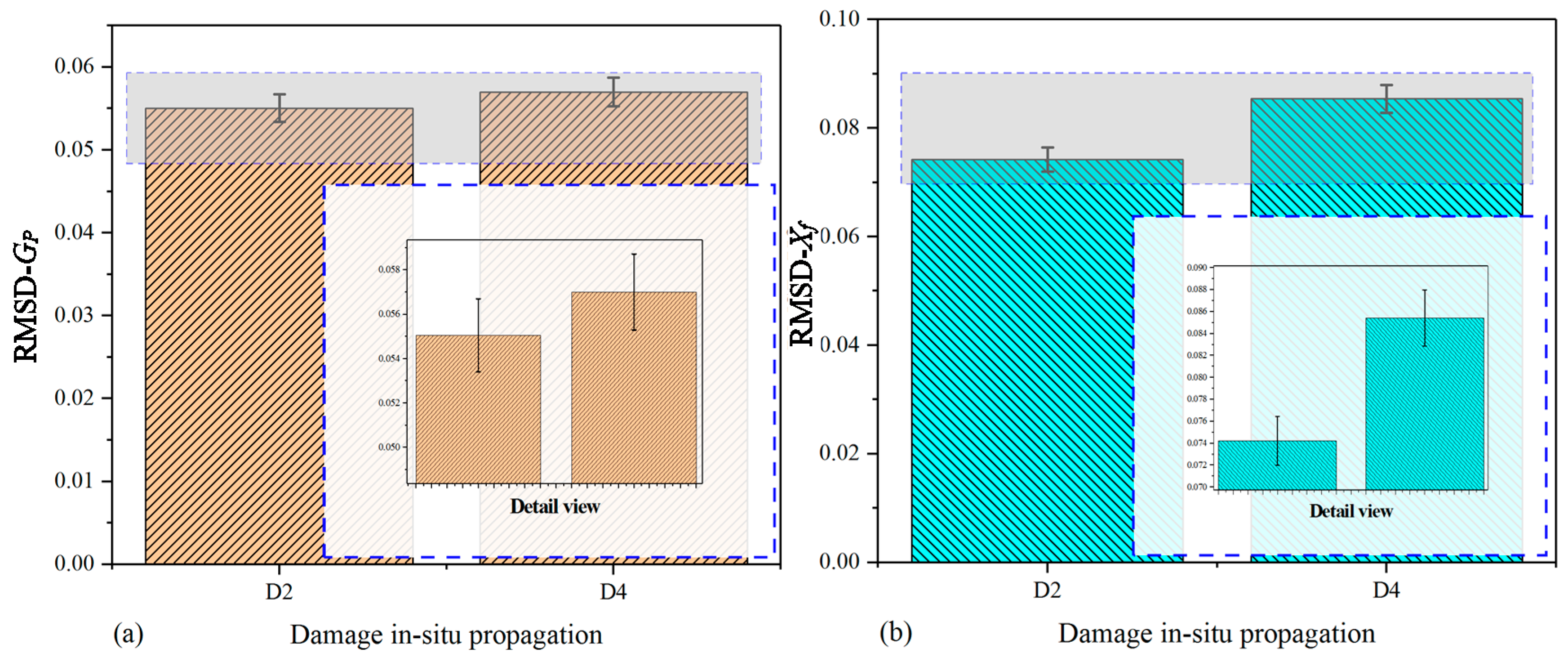
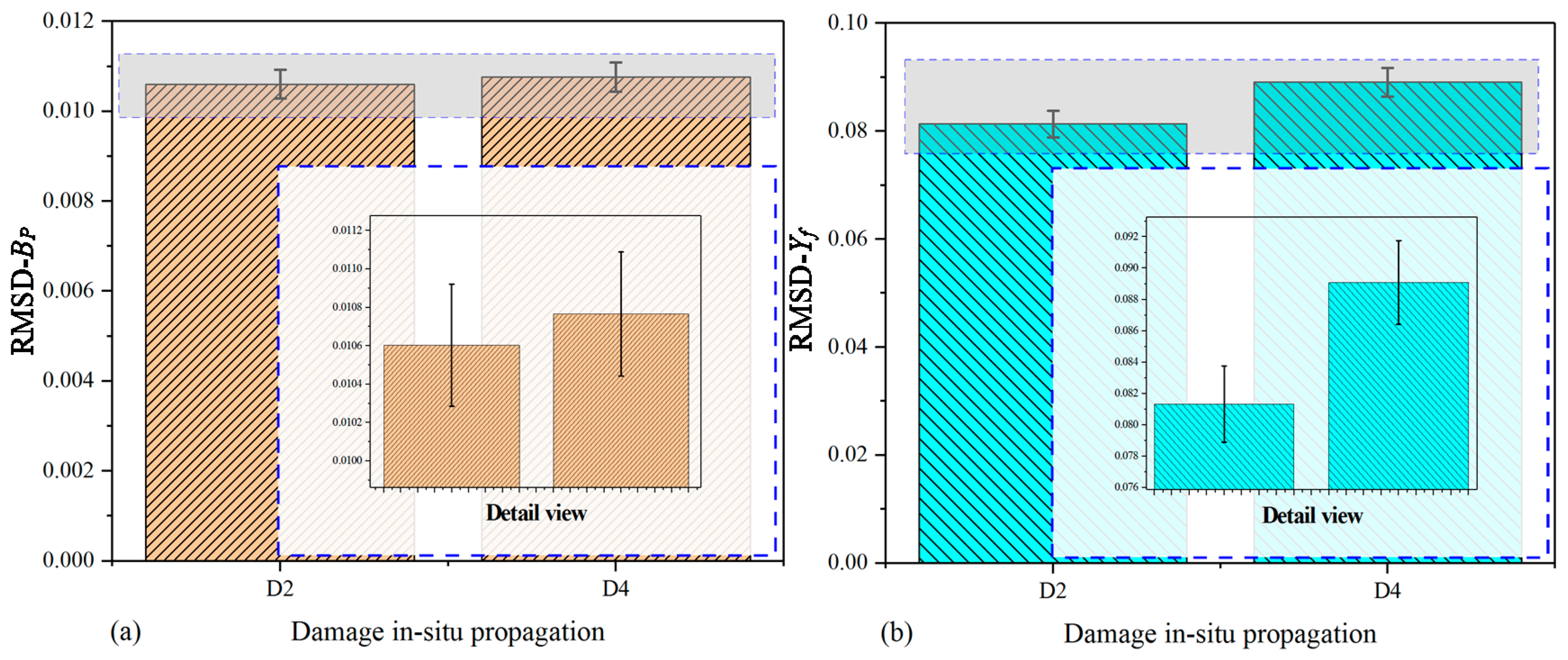
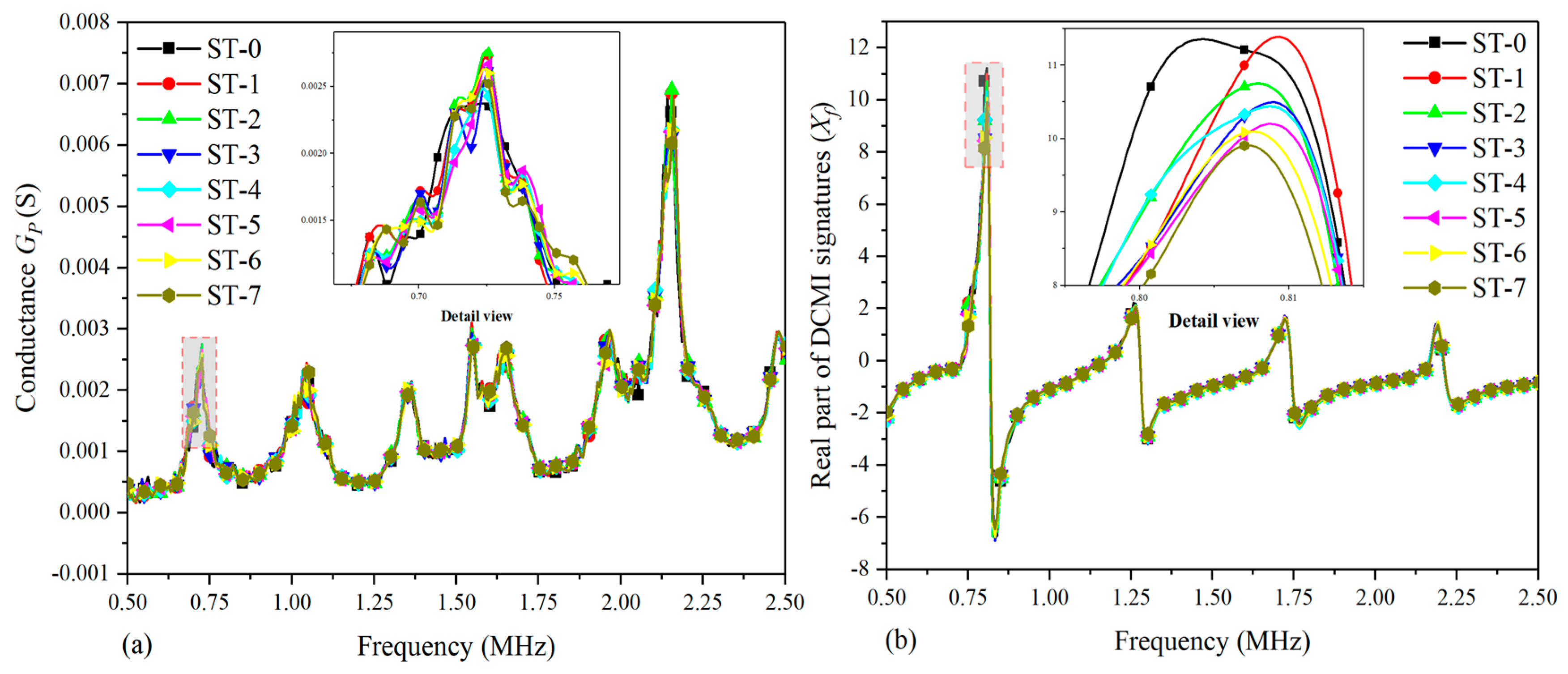
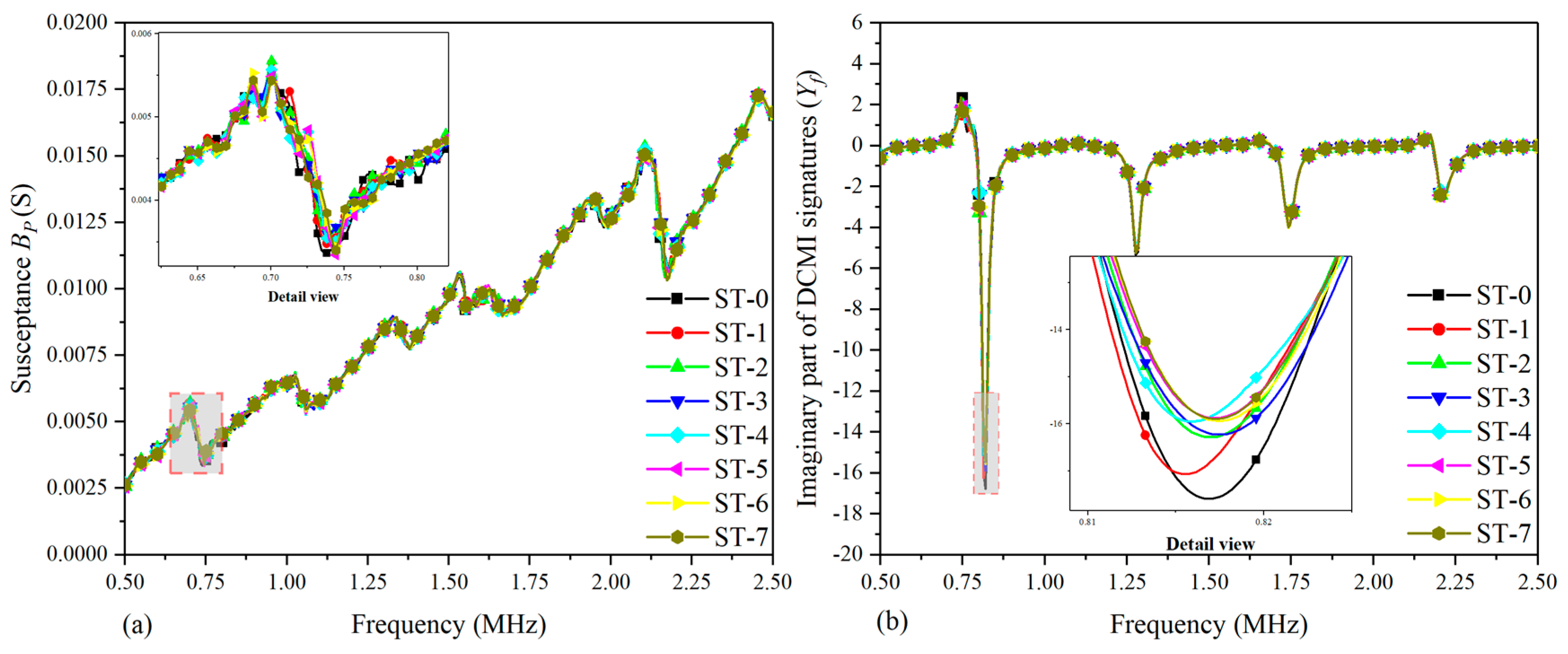
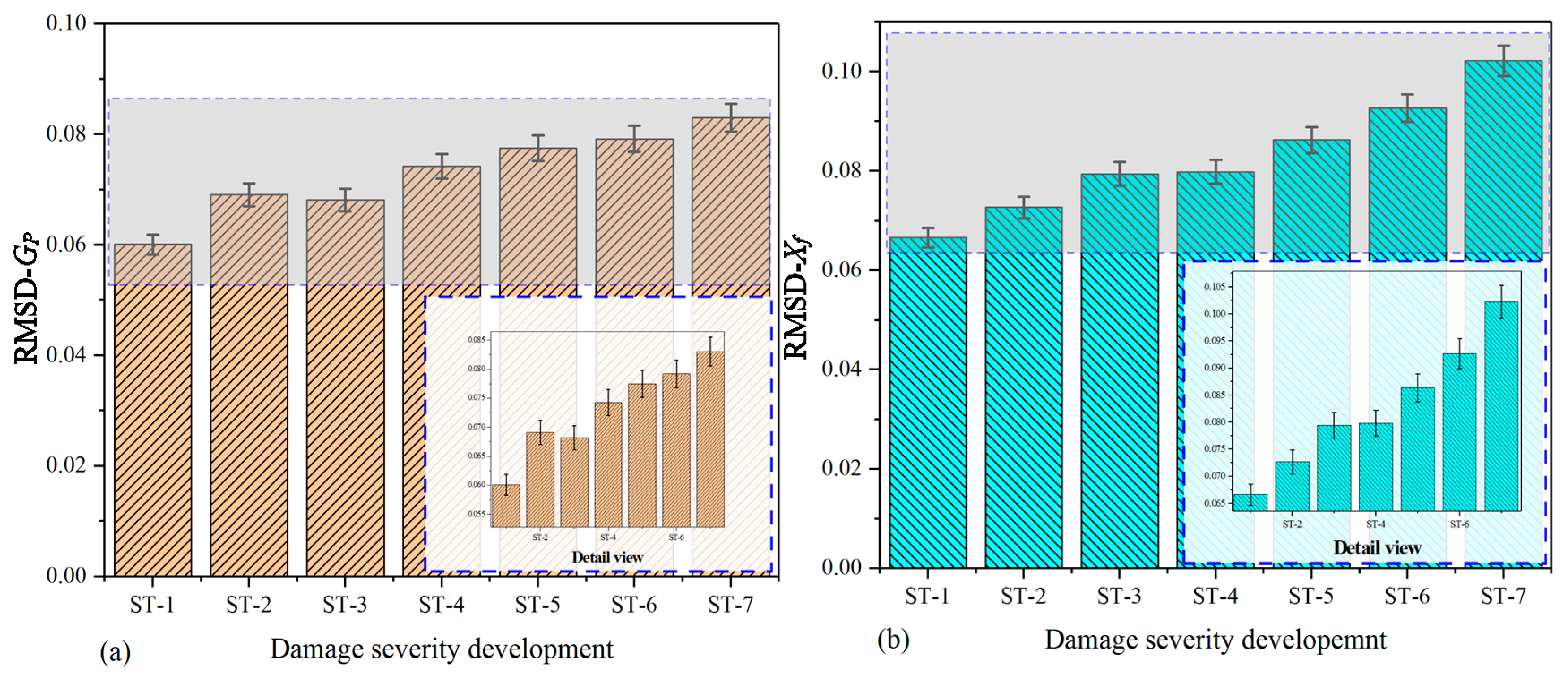
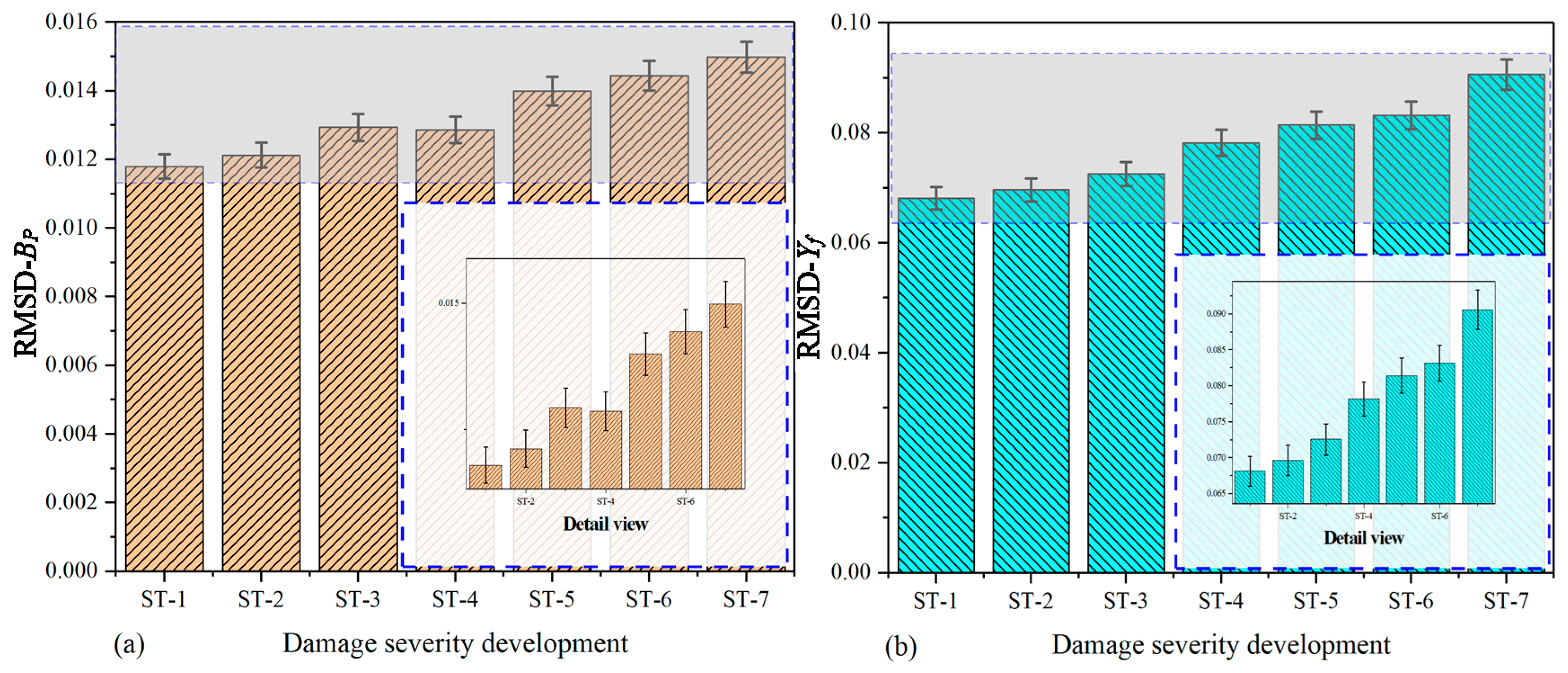


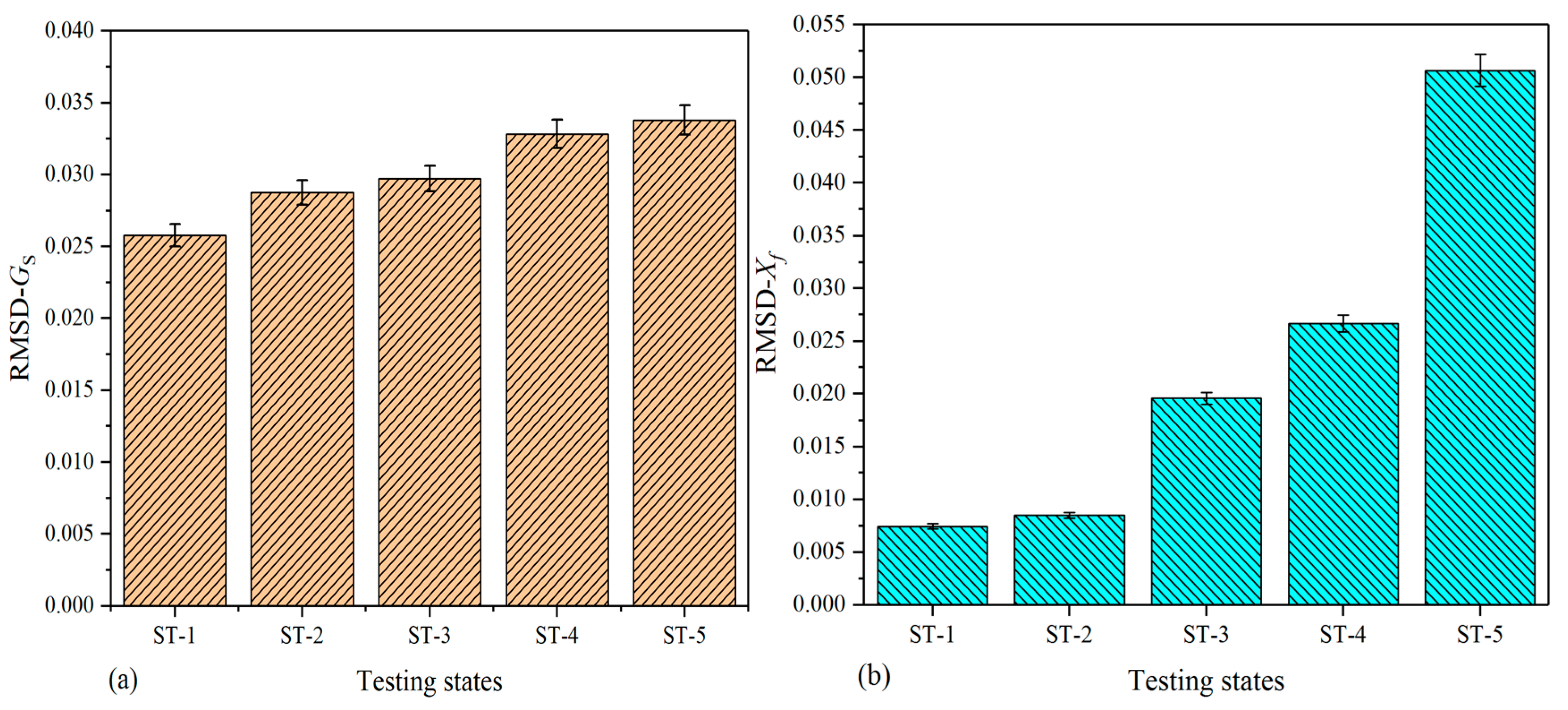
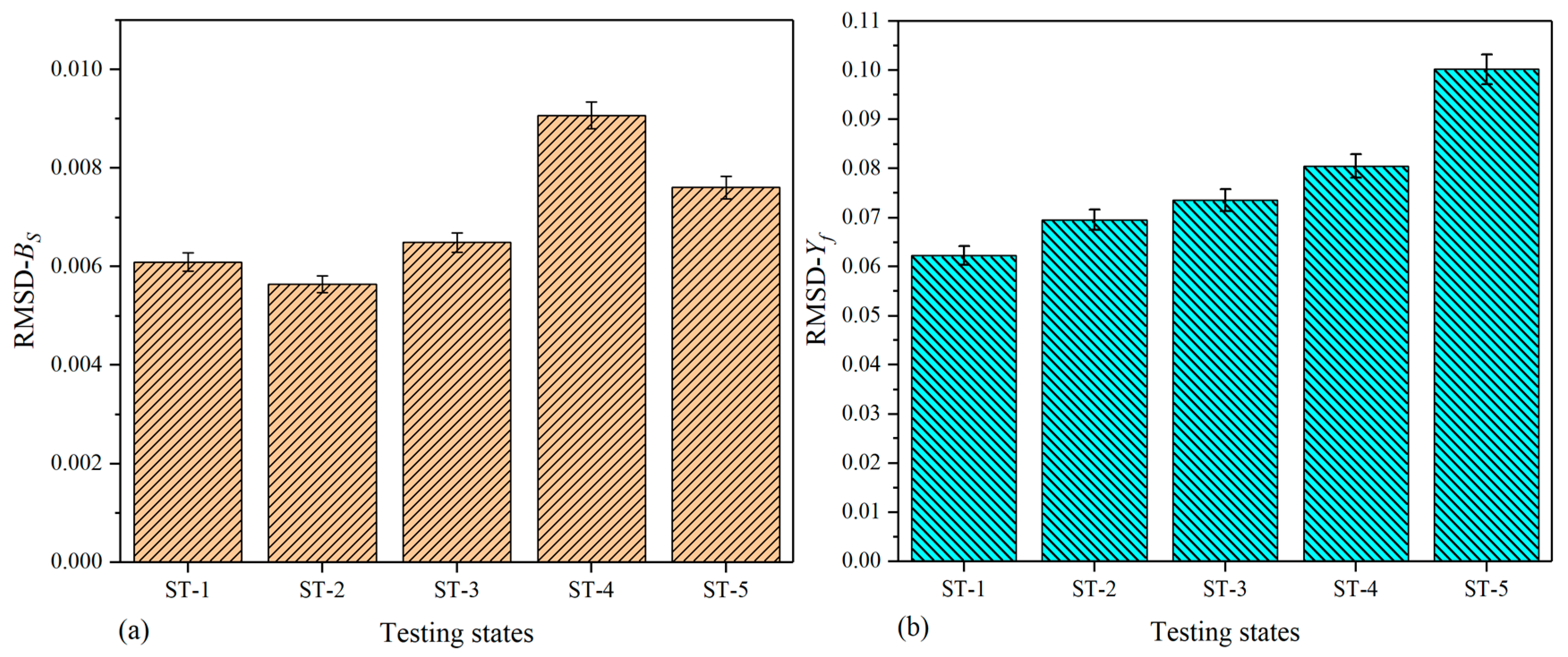
| Testing Specifications | Diameter of Drilled Hole | Damage Area Ratio (%) |
|---|---|---|
| D0 | — | — |
| D2 | 2 mm | 5.236 × 10−3 |
| D4 | 4 mm | 0.021 |
| Physical Parameters | Names | Values |
|---|---|---|
| (10−12m2/N) | Compliance coefficient at constant electric field | 16.43 |
| Mechanical loss factor | 0.025 | |
| Relative permittivity | 1920 | |
| δ | Dielectric loss factor | 0.01 |
| d31(×10−12C/N) | Piezoelectric strain coefficient | −200 |
| Poisson’s ratio | 0.32 | |
| ρ (kg/m2) | Density | 7750 |
| h (10−3 m) | Thickness | 0.5 |
| a (10−3 m) | Radius | 4.2 |
| Testing States on Specimen-2 | Number of Drilled Hole (mm) |
|---|---|
| ST-0 | 0 (Baseline) |
| ST-1 | 1 |
| ST-2 | 2 |
| ST-3 | 3 |
| ST-4 | 4 |
| ST-5 | 5 |
| ST-6 | 6 |
| ST-7 | 7 |
| Testing States on Fuselage | Number of Drilled Hole (mm) |
|---|---|
| ST-0 | 0 (Baseline) |
| ST-1 | 1 |
| ST-2 | 2 |
| ST-3 | 3 |
| ST-4 | 4 |
| ST-5 | 5 |
| States | Raw Signatures | DCMI Signatures | ||
|---|---|---|---|---|
| GP | BP | Xf | Yf | |
| D2 | 0.05505 | 0.01060 | 0.07423 | 0.08133 |
| D4 | 0.05700 | 0.01077 | 0.08542 | 0.08907 |
| States | Raw Signatures | DCMI Signatures | ||
|---|---|---|---|---|
| GP | BP | Xf | Yf | |
| ST-1 | 0.06008 | 0.01180 | 0.06659 | 0.06815 |
| ST-2 | 0.06907 | 0.01212 | 0.07267 | 0.06965 |
| ST-3 | 0.06816 | 0.01294 | 0.07942 | 0.07258 |
| ST-4 | 0.07423 | 0.01287 | 0.07984 | 0.07821 |
| ST-5 | 0.07747 | 0.01400 | 0.08631 | 0.08144 |
| ST-6 | 0.07918 | 0.01444 | 0.09268 | 0.08319 |
| ST-7 | 0.08300 | 0.01498 | 0.10221 | 0.09061 |
© 2019 by the authors. Licensee MDPI, Basel, Switzerland. This article is an open access article distributed under the terms and conditions of the Creative Commons Attribution (CC BY) license (http://creativecommons.org/licenses/by/4.0/).
Share and Cite
Zhu, J.; Wang, Y.; Qing, X. Health Monitoring of Metallic Structures with Electromechanical Impedance and Piezoelectric Sensors. Nanomaterials 2019, 9, 1268. https://doi.org/10.3390/nano9091268
Zhu J, Wang Y, Qing X. Health Monitoring of Metallic Structures with Electromechanical Impedance and Piezoelectric Sensors. Nanomaterials. 2019; 9(9):1268. https://doi.org/10.3390/nano9091268
Chicago/Turabian StyleZhu, Jianjian, Yishou Wang, and Xinlin Qing. 2019. "Health Monitoring of Metallic Structures with Electromechanical Impedance and Piezoelectric Sensors" Nanomaterials 9, no. 9: 1268. https://doi.org/10.3390/nano9091268
APA StyleZhu, J., Wang, Y., & Qing, X. (2019). Health Monitoring of Metallic Structures with Electromechanical Impedance and Piezoelectric Sensors. Nanomaterials, 9(9), 1268. https://doi.org/10.3390/nano9091268







